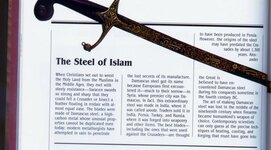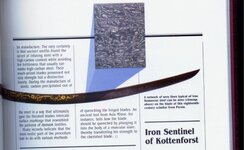Hey George;
I've done quite a bit of knifework, both with damascus and differentially hardened carbon steel. I am fairly confident that I could ID whatever it is you have. If you are going to be down around Atascocita/Crosby anytime soon, your welcome to bring it by the shop. I'm here 8 to 5 weekdays. Drop me a pm for directions.
Some general knowledge on knife materials. Damascus steel is a misnomer. The process that was used to make the ancient blades in the middle east died with it's parent culture a couple of millinia ago, and can by definition never be recovered. Some people claim to have "Reinvented" a process for making a material that is similiar, but no matter how closely a modern material mimics the ancient original, it is not the same. Some will argue with me on that, but I'll stand by it.
Now that being said, there are many wonderfull modern blade materials that sometimes go by the trade name "damascus steel" The most common is "pattern welded" or "forge welded" steel. That is what has been discussed so far, composed of several layers of metals of differing composition, and then welded and folded to produce a pattern. These can vary widely, in both the component materials, and the process and QC of the manufacturing. Take a couple of mediocre steels, and no matter how skillfully you weld and shape them, you get a mediocre blade. Take a couple of wonderfull high quality steels and weld them with poor temp control and process execution, and you get about the same thing. Do the right thing with the right stuff and you can produce a one of a kind work of art that can be turned into a blade that surpasses the quality of anything made in antiquity. As with most things, You get what you pay for.
And finally, once the blade is shaped, heat treated, finished and polished, it must be etched to show the pattern of the materials. Even though the component steels are considered "different" types of steel, they are pretty much identical to the naked eye. The process of etching chemically darkens one steel more than the other, and makes the pattern more visible. However this is basically a surface treatment, and if the surface is removed, the pattern is very difficult to discern, regardless of the quality of the blade. It can always be re-etched however.


